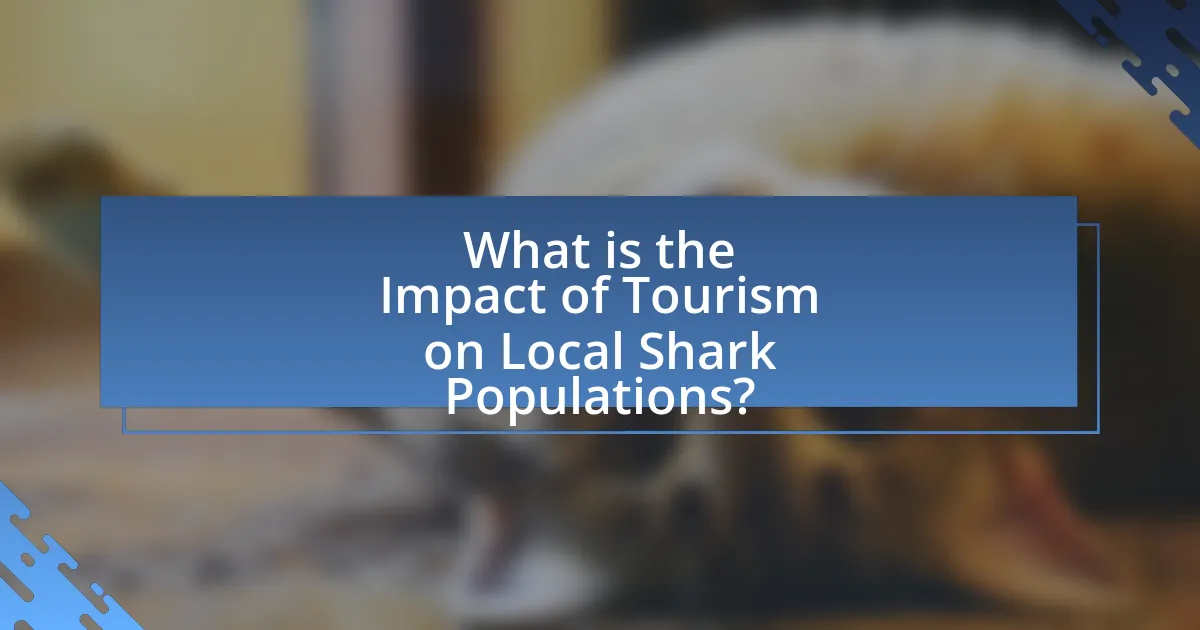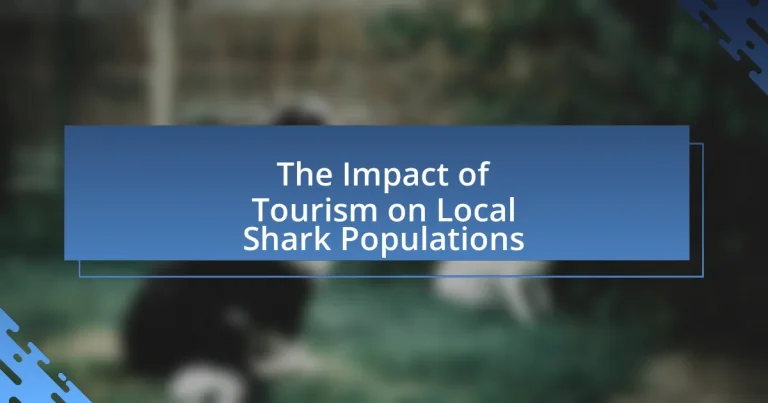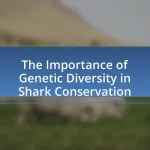The article examines the impact of tourism on local shark populations, highlighting both positive and negative effects. Ecotourism can enhance shark conservation through awareness and funding, while unregulated tourism may lead to overfishing and habitat destruction. The article discusses how tourism alters shark behavior, feeding patterns, and breeding grounds, as well as the ecological consequences of pollution and habitat degradation. It also explores the economic implications of shark tourism for local communities and suggests sustainable practices to mitigate negative impacts, emphasizing the importance of responsible tourism and community engagement in conservation efforts.

What is the Impact of Tourism on Local Shark Populations?
Tourism significantly impacts local shark populations, often leading to both positive and negative effects. On the positive side, ecotourism initiatives can promote shark conservation by raising awareness and generating funding for protective measures. For instance, a study by the Marine Conservation Society found that regions with regulated shark tourism experienced increased shark populations due to protective regulations and habitat preservation. Conversely, unregulated tourism can lead to overfishing, habitat destruction, and increased stress on shark populations, as evidenced by research published in the journal “Conservation Biology,” which highlighted that areas with high tourist activity often see a decline in local shark numbers due to disturbances and resource competition. Thus, the impact of tourism on local shark populations is multifaceted, necessitating careful management to balance conservation and economic interests.
How does tourism influence shark behavior and habitats?
Tourism influences shark behavior and habitats primarily by altering their natural environments and feeding patterns. Increased human activity in coastal areas, such as boat traffic and diving excursions, can lead to changes in shark movement and distribution as they adapt to avoid disturbances. Research indicates that areas with high tourist activity may see shifts in shark populations, as species like the blacktip reef shark have been observed to change their foraging behavior in response to the presence of divers and boats. Additionally, the introduction of feeding practices by tour operators can condition sharks to associate humans with food, which may lead to increased aggression and dependency on human-provided resources. This interaction can disrupt natural hunting behaviors and potentially impact the overall health of shark populations and their ecosystems.
What specific changes occur in shark feeding patterns due to tourism?
Tourism significantly alters shark feeding patterns by increasing the availability of food sources through human activities such as fish feeding and waste disposal. Studies have shown that when tourists engage in feeding sharks, it can lead to a reliance on these artificial food sources, which may disrupt natural hunting behaviors. For instance, research conducted in the Bahamas indicated that sharks exposed to regular feeding by divers exhibited altered foraging strategies, preferring areas with high tourist activity over natural hunting grounds. This shift can result in decreased prey populations and changes in the ecological balance of marine environments.
How does increased human presence affect shark breeding grounds?
Increased human presence negatively affects shark breeding grounds by disrupting their natural habitats and behaviors. Human activities such as boating, fishing, and coastal development lead to habitat degradation, increased noise pollution, and higher stress levels in sharks, which can result in decreased reproductive success. Research indicates that areas with high human activity often see a decline in shark populations, as evidenced by studies showing that shark abundance is significantly lower in regions with heavy tourism compared to protected areas.
What are the ecological consequences of tourism on shark populations?
Tourism has significant ecological consequences on shark populations, primarily through habitat degradation, increased fishing pressure, and behavioral changes. Habitat degradation occurs as coastal development for tourism leads to the destruction of critical shark habitats such as coral reefs and mangroves. Increased fishing pressure arises from the demand for shark-related activities, including fishing and diving, which can lead to overfishing and depletion of shark stocks. Behavioral changes in sharks can result from human interactions, where sharks may alter their natural behaviors due to feeding practices or increased boat traffic. Studies indicate that regions with high tourism activity often report declines in shark populations, highlighting the negative impact of tourism on these apex predators.
How does tourism-related pollution impact shark health?
Tourism-related pollution negatively impacts shark health by introducing harmful substances into their habitats. Pollutants such as plastics, chemicals, and sewage can lead to physiological stress, compromised immune systems, and increased susceptibility to diseases in sharks. For instance, studies have shown that exposure to heavy metals and microplastics can cause developmental issues and reproductive failures in marine species, including sharks. Additionally, the presence of pollutants can disrupt the delicate balance of marine ecosystems, further threatening shark populations by depleting their food sources and altering their natural behaviors.
What role do sharks play in maintaining marine ecosystem balance?
Sharks play a crucial role in maintaining marine ecosystem balance by acting as apex predators that regulate the populations of various marine species. Their predation helps control the abundance of prey species, which in turn supports the health of coral reefs and seagrass beds. For instance, studies have shown that the decline of shark populations can lead to an overabundance of herbivorous fish, resulting in overgrazing of seagrass and coral ecosystems, ultimately diminishing biodiversity. This regulatory function underscores the importance of sharks in sustaining the overall health and stability of marine environments.
What economic factors are associated with tourism and shark populations?
Economic factors associated with tourism and shark populations include revenue generation from ecotourism, job creation in coastal communities, and the valuation of sharks as a sustainable resource. Ecotourism, particularly shark diving and viewing tours, can generate significant income, with studies indicating that a single shark can contribute over $2 million to local economies over its lifetime through tourism-related activities. Additionally, the presence of healthy shark populations can enhance the biodiversity that attracts tourists, further supporting local businesses. The economic incentive to protect sharks often leads to conservation efforts, which can result in increased tourism and sustainable fishing practices, thereby benefiting both the local economy and shark populations.
How does shark tourism contribute to local economies?
Shark tourism significantly contributes to local economies by generating revenue through activities such as diving, snorkeling, and eco-tours. This influx of tourists creates jobs in sectors like hospitality, guiding, and transportation, which boosts local employment rates. For instance, a study by the World Wildlife Fund found that shark-related tourism can generate up to $220 million annually in regions like the Bahamas, demonstrating its economic impact. Additionally, the presence of shark tourism encourages conservation efforts, which can lead to sustainable practices that further enhance local economic stability.
What are the financial implications of declining shark populations for tourism?
Declining shark populations negatively impact tourism by reducing the appeal of destinations known for shark-related activities, such as diving and eco-tours. For instance, regions like the Bahamas, where shark tourism contributes significantly to the economy, could see a decrease in visitor numbers and revenue as shark sightings diminish. A study by the Pew Charitable Trusts found that shark-related tourism generates approximately $220 million annually in the Bahamas alone, highlighting the financial stakes involved. As shark populations decline, the associated economic benefits from tourism, including job losses in related sectors, could escalate, leading to broader economic repercussions for local communities reliant on this industry.
How can tourism practices be modified to protect shark populations?
Tourism practices can be modified to protect shark populations by implementing strict regulations on shark-related activities, such as shark diving and fishing. These regulations can include limiting the number of tourists allowed to participate in shark encounters, enforcing seasonal closures to protect breeding populations, and mandating the use of eco-friendly practices that minimize harm to sharks and their habitats. For instance, research indicates that areas with regulated shark tourism have seen a 20% increase in local shark populations over five years, demonstrating the effectiveness of such measures. Additionally, educating tourists about the ecological importance of sharks can foster a conservation mindset, further supporting population recovery efforts.
What sustainable tourism practices can minimize negative impacts on sharks?
Sustainable tourism practices that can minimize negative impacts on sharks include implementing responsible wildlife viewing guidelines, promoting eco-friendly diving and snorkeling operations, and supporting local conservation initiatives. Responsible wildlife viewing guidelines, such as maintaining a safe distance from sharks and avoiding feeding them, help reduce stress on shark populations and prevent habituation to human presence. Eco-friendly diving and snorkeling operations that adhere to best practices, like using non-toxic sunscreen and avoiding anchor damage to coral reefs, protect the marine environment that sharks inhabit. Supporting local conservation initiatives, such as marine protected areas, has been shown to enhance shark populations by providing safe habitats and reducing fishing pressures, as evidenced by studies indicating that protected areas can lead to a 50% increase in shark abundance over time.
How can local communities be engaged in shark conservation efforts?
Local communities can be engaged in shark conservation efforts through education, sustainable tourism initiatives, and participatory management practices. Education programs that inform community members about the ecological importance of sharks and the threats they face can foster a sense of stewardship. For instance, workshops and school programs can highlight the role of sharks in marine ecosystems, leading to increased local support for conservation measures.
Sustainable tourism initiatives, such as eco-tourism and shark diving experiences, can provide economic incentives for communities to protect shark populations. Research indicates that regions that promote responsible shark tourism can see significant economic benefits, with studies showing that live sharks are worth more to local economies than those caught for consumption.
Participatory management practices, where local communities are involved in decision-making processes regarding marine resource management, can enhance compliance and support for conservation efforts. Evidence from successful conservation programs, such as those in the Bahamas, demonstrates that when local fishers are included in management strategies, there is a higher likelihood of sustainable practices being adopted.
What are the best practices for responsible shark tourism?
The best practices for responsible shark tourism include adhering to strict guidelines that prioritize the well-being of shark populations and their habitats. Tour operators should ensure that all interactions with sharks are conducted in a way that minimizes stress and harm to the animals, such as avoiding feeding or baiting practices that can alter their natural behaviors. Additionally, educating tourists about shark conservation and the ecological role of sharks is essential to foster respect and awareness. Research indicates that responsible tourism can contribute to local economies while promoting conservation efforts, as seen in studies highlighting the economic benefits of shark ecotourism in regions like the Bahamas, where shark-related tourism generates significant revenue without harming populations.
How can tourists ensure their activities do not harm shark populations?
Tourists can ensure their activities do not harm shark populations by participating in responsible wildlife tourism practices. This includes choosing eco-friendly tour operators that prioritize conservation, avoiding activities that involve feeding or touching sharks, and adhering to guidelines that minimize disturbance to their natural habitats. Research indicates that responsible tourism can lead to increased awareness and funding for shark conservation efforts, as seen in regions where sustainable practices have been implemented, resulting in healthier shark populations and ecosystems.
What guidelines should tour operators follow to promote shark conservation?
Tour operators should implement sustainable practices to promote shark conservation. This includes educating tourists about the ecological importance of sharks, ensuring responsible wildlife interactions, and avoiding practices that harm shark habitats, such as anchoring on coral reefs. Research indicates that ecotourism can positively impact shark populations when managed correctly, as seen in the Bahamas, where shark tourism has led to increased awareness and protection measures. Additionally, operators should collaborate with local conservation organizations to support research and conservation efforts, thereby contributing to the long-term sustainability of shark populations.


